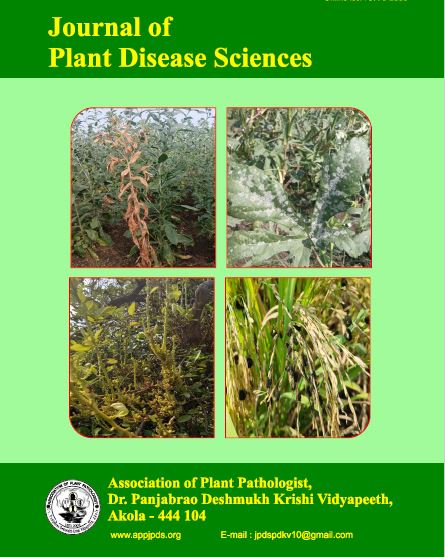DEMONSTRATION OF CHILLI ( L.) HYBRIDS FOR GROWTH, YIELD AND MAJOR DISEASES IN NORTHERN DRY ZONE OF KARNATAKA
DOI:
https://doi.org/10.48165/jpds.2024.1901.15Keywords:
Chilli hybrids, Arka Kyati, Arka Meghana and Powdery mildewAbstract
Chilli hybrids are demonstrated in farmers’ fields of Hadagali and Arakeri blocks of Vijayapura district on nearly 50ha area,for the year 2019-20 and 2020-21 under on farm testing trials. Arka Kyati, Arka Meghana and local variety were used in this study. Arka Kyati recorded highest growth characters like plant height (47.24 cm), number of fruits/plant (78.30), fruit weight (5.31 g) and fruit length (10.19 cm) followed by Arka Meghana with 48.54cm; 67.50; 5.20g and 10.10 cm, respectively, whereas local hybrid recorded the lowest values for all the traits. Arka Kyati took the minimum number of days for 50 per cent flowering (43). Arka Kyati hybrid recorded the highest per plantyield (413.00 g) and total yield/ha (15.47 t/ha) followed by Arka Meghana (388.90 g; 13.26 t/ha). Arka Kyati recorded lowest thrips and Powdery mildew incidence (16.25% and 7.89%) whereaslocal checkrecordedthe lowest yield of 11.98 t/ha and highest thrips and powdery mildew incidence (20.36% and 13.28%). In the case of benefit cost ratio, Arka Kyati recorded the highest B:C ratio of2.37 with the net profit of Rs. 1,89,616. Arka Kyati hybrid is performed well and increasedyieldof 17.30 per cent.
References
Anonymous., 2014: Crop Production Guide – 2014. Tamil Nadu Agricultural University, Coimbatore.
Bhattacharya, A., A. Chattopadhyay, D. Mazumdar, A. Chakravarty and S. Pal., 2010: Antioxidant constituents and enzyme activities in chilli peppers. International Journal of Vegetable Sciences, 16(3): 201-211.
Bosland, P. W and E. J. Votava, 2000: Peppers: Vegetable and spice capsicums. CABI Publishing, CAB International, Walingfort,U.K.
Das, B., M. S. Hazarica and P. K. Das, 1998: Studies on variability and correlation studies in fruit haracters of tomato (Lycopersicones culentum Mill.). Annual Agriculture Research, 19(1): 77-
80.
Hadora, R., T. B. Puttaraju and V. Damodar, 2017: Assessment of stability patterns in some selected chilli hybrids (Capsicum annuum L.). Advancesin Research, 10(1):1 – 11.
Kavitha, P. S., A. Sudha and S. Srividya, 2018: Assessment of chilli varieties in Salem district for higher productivity. Journal of Horticultural Sciences,13(1): 119-121.
Kogure, K., S. Goto, M. Nishimura, M. Yasumoto, K. Abe and L. Ohiwa, 2002: Mechanism of potent anti peroxidative ef fect of capsaic in. Biochimicaet Biophysica Acta, 1573: 84-92.
Mehraj, H., Tamima Haider, M.S.N. Chowdhury, M.H. Ferdous and A.F.M. Jamal Uddin, 2014: Study on morphophysiological characteristics and yield performance of four chilli lines. Journal of Bioscience Agriculture Research, 2(1): 1-7.

